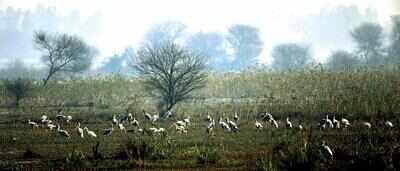
LUCKNOW: The state is walking the extra mile to protect its wetlands. Six of them have been declared Ramsar sites this year and UP’s first Wetlands Authority has begun notifying wetlands lying both inside and outside forests.
A Ramsar site is a wetland designated to be of international importance under the Ramsar Convention signed in Iran in 1971.
Out of 37 wetlands declared Ramsar sites in India, now seven belong to UP. The list includes Nawabganj in Unnao, Parvati Aranga in Gonda, Saman in Mainpuri, Samaspur in Rae Bareli, Sandi in Hardoi and Sarsai Nawar in Etawah, which have made it to the list this year. The upper Ganga river, the stretch from Brigghat to Narora, is the state’s first Ramsar site, declared in 2005.
Sources in the government said while the Ramsar tag may not bring funds for conservation, but it was enough to secure international spotlight. “The declaration makes clear that six wetlands have met international scientific and technical parameters,” said a source.
The declaration comes at a time the state government has constituted UP’s first Wetlands Authority which, sources said, is still in a nascent stage. “The authority will identify and prepare a wetland atlas for the state, including the ones lying outside forest. The process to notify Ramgarh Taal has started. It lies outside forest,” a source said.
UP has around 1.2 lakh wetlands that lie outside forests and around 500 that lie within. According to the national wetland atlas that is based on satellite data, out of the 1.2 lakh in UP at least 23,800 are more than 2.2 hectare in area and need conservation. However, going by revenue records, UP has at least 26,000 wetlands that are bigger than 2.2 hectare.
Once the wetlands are notified, they will be covered under the Wildlife Protection Act. Conservation efforts will also involve developing a connect between people and wetlands such as promoting eco-tourism, fisheries and other economic activities.
Wetlands are shallow water bodies spread over an area of at least 3 hectare or those with water as deep as 30cm for a period of six months. It is the changing land-use pattern that is the biggest threat to wetlands.
A Ramsar site is a wetland designated to be of international importance under the Ramsar Convention signed in Iran in 1971.
Out of 37 wetlands declared Ramsar sites in India, now seven belong to UP. The list includes Nawabganj in Unnao, Parvati Aranga in Gonda, Saman in Mainpuri, Samaspur in Rae Bareli, Sandi in Hardoi and Sarsai Nawar in Etawah, which have made it to the list this year. The upper Ganga river, the stretch from Brigghat to Narora, is the state’s first Ramsar site, declared in 2005.
Sources in the government said while the Ramsar tag may not bring funds for conservation, but it was enough to secure international spotlight. “The declaration makes clear that six wetlands have met international scientific and technical parameters,” said a source.
The declaration comes at a time the state government has constituted UP’s first Wetlands Authority which, sources said, is still in a nascent stage. “The authority will identify and prepare a wetland atlas for the state, including the ones lying outside forest. The process to notify Ramgarh Taal has started. It lies outside forest,” a source said.
UP has around 1.2 lakh wetlands that lie outside forests and around 500 that lie within. According to the national wetland atlas that is based on satellite data, out of the 1.2 lakh in UP at least 23,800 are more than 2.2 hectare in area and need conservation. However, going by revenue records, UP has at least 26,000 wetlands that are bigger than 2.2 hectare.
Once the wetlands are notified, they will be covered under the Wildlife Protection Act. Conservation efforts will also involve developing a connect between people and wetlands such as promoting eco-tourism, fisheries and other economic activities.
Wetlands are shallow water bodies spread over an area of at least 3 hectare or those with water as deep as 30cm for a period of six months. It is the changing land-use pattern that is the biggest threat to wetlands.
Get the app









